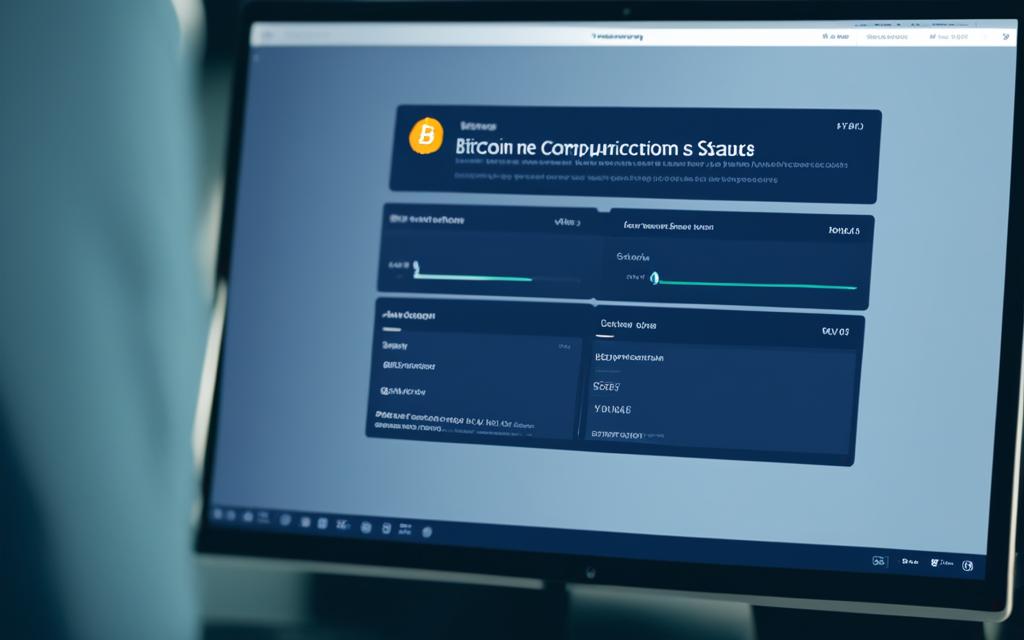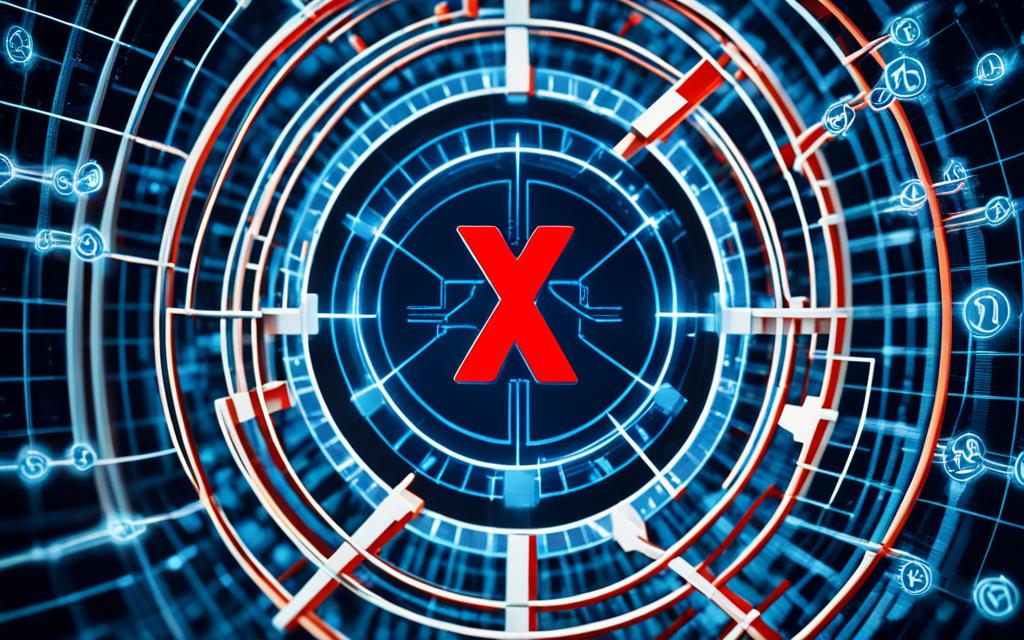Table of Contents
When you send a Bitcoin transaction, it may not get confirmed if the miner fee is too low. Miners won’t process it without a sufficient fee. This means your money could get stuck without reaching its destination.
Statistics show1 that the chance to cancel such a transaction depends on this fee. If the fee is not enough, you might be able to cancel it. Yet, once your Bitcoin transaction gets confirmed, it’s final. No one can change that1.
There are two ways to cancel such a Bitcoin transaction. The first method is to use the Replace by Fee (RBF) protocol. This method lets you increase your transaction’s fee to get miners’ attention. Not all wallets have this RBF feature, so check first2.
The other way is to perform a double spend but with a higher fee. This method involves sending a new transaction with more fees. It aims to grab miners’ focus away from the old transaction. However, it’s not a guaranteed method because miners and wallets try to prevent double spending1.
Key Takeaways:
- You can cancel unconfirmed Bitcoin transactions with low fees1.
- Once a Bitcoin transaction confirms, it can’t be changed, with a 100% finality rate1.
- The RBF protocol and double spending are two ways to cancel transactions2.
- Check if your wallet supports RBF before trying to cancel a transaction2.
- Miners and wallets work to prevent double spends, making it a harder route to cancel1.
Learning about unconfirmed Bitcoin transactions and how to deal with them helps ensure your transactions are processed smoothly on the blockchain. In our next sections, we’ll explore confirming and cancelling unconfirmed Bitcoin transactions further, looking at common issues and how to make transactions easier for you.
Understanding Bitcoin Transaction Confirmations
Before trying to cancel an unconfirmed Bitcoin payment, you must get what ‘transaction confirmations’ mean. A transaction is only complete when it’s added to a block and noted on the blockchain. This makes it final and can’t be changed. The more confirmations, the more sure you can be that it’s safe.
Not putting enough in the transaction fee can lead to an unconfirmed payment3. If the fee isn’t tempting enough for miners, they might skip your payment. The lesson here is: choosing the right fee is crucial for quick confirmation.
Too many transactions happening at once can slow the system down3. An overloaded network means your transaction might take longer to get through. It shows how vital network capacity is for smooth operations.
Trying to spend the same bitcoins twice can slow everything down3. This shady manoeuvre, known as double spending, delays confirmations. The network needs more time to check the payment’s validity.
Moving bitcoins just received should be done carefully3. Wait for enough confirmations to make sure your first transaction was legit. This is important to avoid any double spending trouble.
Don’t overlook technical issues in unconfirmed transactions3. Glitches during transactions can create delays. This means tech problems may cause a transaction to hang.
To really understand Bitcoin confirmations, we’ll check some actual data next.
Checking the Status of Your Bitcoin Transaction
You can check your Bitcoin transaction’s status with the transaction ID. Use a block explorer like Blockchain.com or Tokenview.io. Just enter the transaction ID to see its details.
This includes the number of confirmations. Confirmations show how many blocks have the transaction. This means more confirmations bring more security and make the transaction harder to reverse.
Each new block adds to the blockchain increases security. More confirmations mean more agreement in the Bitcoin network. They protect against wrong transactions, making Bitcoin safer.
If your Bitcoin transaction has zero confirmations, it’s not yet confirmed. Being in a block makes a transaction confirmed.
Delays in confirmation can happen when the network is busy. High traffic and low fees can slow down confirmations.
There’s no set time for a transaction to get confirmed. It usually takes about 10 minutes4. But, network conditions and transaction details influence this time.
Users can speed up confirmations by paying a higher fee or using Replace-by-Fee (RBF). Most wallets today support RBF, helping users get their transactions confirmed faster.
Block explorers not only check transaction status. They also show transaction details and network activity. Sites like Blockchain.com and Tokenview.io are great for keeping track.
By looking at confirmations, users can trust their Bitcoin transactions more. Remember, different services have different rules on how many confirmations are needed.
It’s key to check your Bitcoin transaction. This keeps your money safe and your mind calm. Blockchain explorers help you stay updated on your transactions.

Factors Affecting Bitcoin Transaction Confirmations
| Factors | Impact on Confirmations |
|---|---|
| Network Congestion | Can lead to delays in transaction confirmations as miners prioritize transactions with higher fees. |
| Transaction Size | Larger transactions may require more confirmations for added security. |
| Transaction Fee | Transactions with higher fees are more likely to be included in a block by miners. |
| Miner Activity | The number of active miners and their behavior can influence confirmation times. |
| Blockchain Explorer | Provides a way to monitor transaction status and confirmation progress. |
Table: Factors Affecting Bitcoin Transaction Confirmations
Methods for Canceling Unconfirmed Bitcoin Transactions
Canceling unconfirmed Bitcoin transactions involves two main methods. These are Replace by Fee (RBF) and double spending. Below, we will delve into each one.
Replace by Fee (RBF)
With RBF, users can swap their first Bitcoin transfer for a new one. The new one has a higher fee. This motivates miners to give their transaction priority. RBF is available on some wallets and has proven to be a reliable method5.
Double Spending
Double spending means sending a higher-fee transaction to yourself. It’s an option when RBF isn’t. This way, users make their new transaction more appealing to miners, possibly voiding the original transaction. Note that not all wallets are compatible with this technique, and it requires special skills5.
Key things to think about before trying to cancel a Bitcoin transaction include:
- Network Congestion: High traffic can lead to unconfirmed transactions. The system might not handle all pending transactions at once, causing delays5.
- Low Transaction Fees: Transactions may remain unconfirmed if the fee is too low. Miners look for higher fees to earn more5.
- Waiting Period: Waiting 24 hours before acting is a good idea. By then, the network might be less busy, improving the chances of confirmation5.
By knowing these factors and the right methods, users have a good chance at canceling unconfirmed transactions. Check if your wallet allows RBF or double spending first5.
If you’re more of a visual learner, check out the table below for a clearer view of the methods:
| Method | Pros | Cons |
|---|---|---|
| Replace by Fee (RBF) | – Supported by certain wallets – Reliable cancellation method – Allows users to increase transaction fee |
– Not universally supported by all wallets |
| Double Spending | – Can be used in place of RBF – Allows users to create a higher fee transaction |
– It demands a certain level of expertise – May not work with all wallets |
Using the right approach and understanding the reasons for unconfirmed transactions puts you in control. Stay up-to-date with Bitcoin news to make smart choices about handling your transactions5.
Using Replace by Fee (RBF) to Cancel Unconfirmed Bitcoin Transactions
Have you ever been stuck with an unconfirmed Bitcoin transaction? You can use Replace by Fee (RBF) to fix this. It lets you send a new transaction with a higher fee to replace the old one. This speeds up the process of getting your transaction confirmed6.
To start, your original Bitcoin transaction must use RBF. You should choose this option when making the initial transaction6.
Once your new RBF transaction is out there, miners will pick it up first. This cancels the old, unconfirmed one7.
Keep in mind, not all wallets support RBF. So, it might not work for everyone6.
If you’re a Trezor Suite user, good news: RBF is now available in version 21.2.2. It works with different Trezor devices, letting you easily adjust the fee to get your transaction through6.
With Trezor Suite and RBF, you can do two main things. You can increase the fee to make it faster, or you can finalize the transaction6.
For peace of mind with certain non-RBF accepting merchants, you can simply turn RBF off in Trezor Suite6.
Electrum also supports RBF. But, you can only replace a transaction if you chose the “Replace by fee” option initially6.
RBF provides Bitcoin users with flexibility. They can adjust fees to get faster confirmations or make other fee changes7.
Still, there are things to watch out for with RBF. It could lead to double-spending, confuse users, or cause network troubles7.
Sometimes, using RBF can lead to issues like overwrites or misunderstandings with the recipient8.
Because some might try to misuse RBF, it’s important to use it wisely and educate yourself about it7.
To wrap up, RBF is a great tool for dealing with unconfirmed Bitcoin transactions. But, make sure it works with your wallet and understand the risks. Use it carefully to avoid problems6.
Double Spending to Cancel Unconfirmed Bitcoin Transactions
If the Replace by Fee (RBF) policy isn’t an option, cancelling an unconfirmed Bitcoin transaction might require a different route. This method is known as double spending with a higher fee9. The approach means creating and sending a new transaction to yourself. This new transaction will carry the same amount but with a much higher fee. This higher fee might make miners prefer the new transaction, effectively cancelling the original. Yet, it’s crucial to understand that not all miners and wallets will agree to this method.
Attempting to double spend with a higher fee brings risk. Miners-wise and wallets are set up to catch and stop such actions10. They use policies and systems that help them pick out true transactions from attempts to double spend.
Before trying to cancel an unconfirmed transaction through double spending, think about the wider effects. The Bitcoin network’s trust and value depend on the integrity of its transactions11. A successful double spend could lead to issues like more money in circulation, lower trust in Bitcoin, and fraud. This could all weaken Bitcoin’s reliability and security.
Remember to be cautious and follow recommended steps for dealing with Bitcoin transactions. Waiting for enough confirmations gives stronger proof of a valid, unchangeable transaction. On average, transactions get confirmed every 10 minutes9. For payments under $1,000, one confirmation is normally safe. But for payments up to $10,000, three confirmations are advised. For much bigger payments, waiting for six confirmations is the smart move9.
Improving Bitcoin’s transaction security is a top concern in the cryptocurrency world. Setting up protocols to stop double spending is crucial for Bitcoin’s honesty and endurance10.
If you want to know more about double spending and how to deal with unconfirmed Bitcoin transactions, check out these links:
- Gemini – Double Spending Problem in
- CoinDesk – Is Double Spending Unconfirmed Transactions a Concern for Bitcoin
- 99Bitcoins – A Deep Dive Into Double
Being well-informed about the risks of double spending and unconfirmed transactions helps you make wise choices with your Bitcoin.
Reasons for Unconfirmed Bitcoin Transactions
There are many reasons why a Bitcoin transaction may not go through. These include low miner fees, very big transactions, lots of network traffic, and not enough money12. It’s key to know these if you want to cancel a stuck transaction.
For a Bitcoin transaction to be secure, it needs at least three confirmations2. To get these confirmations, several blocks must be added to the blockchain. This process takes around 10 minutes but can be quicker or slower due to various reasons2.
If your transaction fee is very low, or not enough to cover the whole fee, it might not confirm2. Transaction fees change based on network demand and how big your transaction is12. When the network is busy, people might pay higher fees to get processed faster12.
Using old protocols or wallets can also cause unconfirmed transactions. Wallets and exchanges might need different numbers of confirmations. Make sure your and the other person’s wallets can work together. This prevents problems12.
Sometimes, you can fix an unconfirmed transaction by using RBF or sending a new transaction with a higher fee2. RBF lets you replace your old transaction with one that has a better fee1. This might help your transaction go through faster. But be careful when doing this. Sending a transaction twice has risks21.
It’s important to know why Bitcoin transactions get stuck. Understanding miner fees, transaction sizes, and network issues can help. It lets users take the right steps to fix their transactions
.
Troubleshooting Unconfirmed Bitcoin Transactions
When Bitcoin transactions don’t confirm, it’s crucial to understand the reasons. Several issues can lead to this, like low fees, wallet sync problems, wrong addresses, or network traffic. To fix these issues, knowing the problem is half the battle. Then, taking proper steps is the key to solve it.
Verifying Transaction Details and Fee
Low fees are a big reason behind slow Bitcoin transactions. Miners often pick transactions with higher fees to include first. So, to make your transaction get confirmed faster, check the fee you’re offering. Make sure it’s a decent one to get noticed by miners.
Checking Internet Connection
Having a poor internet connection can make your transactions not reach the miners. To fix this, check and strengthen your internet connection. A good, stable internet connection is crucial for your transactions to go through smoothly.
Ensuring Wallet Synchronization
Wallets need to sync to the latest data for transactions to confirm. If your wallet’s not updated, it may lead to issues. Let your wallet update to the latest version so it’s in tune with the network.
Resending the Transaction
If waiting too long, try resending your transaction with a higher fee. The RBF protocol lets you do this easily. Or, you can send a new transaction that’s exactly the same but with a better fee. This should help your transaction confirm sooner.
Dealing with these issues can make your Bitcoin transactions smoother and faster. Improving user experience is key in the digital currency world. Ensuring transactions flow without problems is important for everyone involved.
| Month | Average Confirmation Time |
|---|---|
| April 2021 | Approximately 10 minutes13 |
Note: The table above shows the average confirmation time for Bitcoin transactions in April 2021, which is approximately 10 minutes13.
Ensuring Confirmation of Bitcoin Transactions
When you carry out Bitcoin transactions, making sure they confirm is key. This step helps dodge possible problems and waiting times. By using a few important strategies, you raise the success odds and cut down on the risk of transactions not confirming.
Include Sufficient Transaction Fees
The amount you pay as a fee is a big deal for confirming transactions. Most wallets pick the fee for you, which avoids problems. It’s critical to make sure your transaction fee is enough for a quick confirmation4.
Verify Transaction Details and Avoid Errors
Checking all your transaction details twice is crucial. A mistake like sending money to the incorrect address can lead to a failed transaction. Take a moment to make sure all addresses and amounts are right before you press ‘send’4.
Avoid Network Congestion
When lots of people are trading Bitcoin, things may slow down. This could mean longer waits for your transaction to confirm. It’s smart to wait for a quieter time to make your trades. This can make everything faster4.
Keep Your Internet Connection Stable
Having a steady internet connection is vital for your transactions. A bad or off-and-on connection can stop your transaction from going through fast. Always check that your internet is strong before you trade4.
Understand Transaction Prioritization
Miners pick transactions with higher fees first because they make more money that way. Lower fee transactions might have to wait longer. Adding a bit more to your fee can help speed things up42.
Utilize Replace-by-Fee (RBF)
With Replace-by-Fee (RBF), you can up your fee to get a transaction moving quicker. This tool is handy when you need to change fees or speed up confirmations. But remember, not all wallets have RBF, so check first before trusting it42.
Consider the Child Pays for Parent (CPFP) Method
The Child Pays for Parent (CPFP) method boosts your transaction’s fee by using the original payment. This trick can get your original transaction confirmed faster. It’s great for dealing with transactions that are stuck4.
By using these methods, your Bitcoin transactions have a better chance of success. Always remember, how long a transaction takes to confirm varies. By learning and being ready, you can smoothly handle Bitcoin’s changes and reduce unconfirmed transaction risks.
Using Bitcoin Transaction Accelerators
If you have a Bitcoin transaction waiting too long to confirm, there’s a way to speed it up. This is where Bitcoin transaction accelerators come in.
These accelerators work by offering to process your transaction quicker for a fee. You can avoid long waits by using their services. This way, your transaction is confirmed promptly.
Choosing the right accelerator is important. Make sure it’s known for working well and being trustworthy. Look into your options carefully before picking one.
- BTC.com: BTC.com’s service guarantees a 75% chance of confirming within 1 hour and 98% within 4 hours14.
- ViaBTC: ViaBTC lets you choose between free and paid acceleration. The free can handle up to 100 transactions hourly, while the paid offers 1,000 for a small fee of 0.0001 BTC/KB14.
- ConfirmTX: ConfirmTX aims to confirm your transaction in less than 12 hours. They offer credit toward future accelerations if it takes longer than 72 hours14.
- 360 BTC Accelerator: This accelerator, 360 BTC, has cleared over 1,000 transactions and has no size limit14.
- BTC Nitro: BTC Nitro has a $25 option for guaranteed confirmation within an hour. They refund if it’s not confirmed in 24 hours14.
- BTC Afterburner App: The BTC Afterburner App specialises in the CPFP method and charges $5.99 for the service14.
- Binance BTC Transaction Accelerator: Binance’s service is paid and requires a verified Binance Pool account to use14.
- BitTools: BitTools offers a free service that resubmits your transaction to 17 nodes. You can retry every 6 hours until it’s confirmed14.
When considering using an accelerator, advice from trusted sources is wise. Unchained suggests careful research first. They also offer professional support and guidance for CPFP if your transaction involves change15.
The CPFP method is useful with transactions involving change. It tweaks fees and details to speed up confirmations for both transactions15.
“Bitcoin transaction accelerators can help expedite the confirmation process, ensuring your transaction gets confirmed in a timely manner by leveraging higher fees and the CPFP method.”1514
On average, Bitcoin processes 7 transactions a second and 608,400 a day14. Confirmation times vary but often take around 10 minutes4. Fees, network congestion, and the type of protocol used can all affect the speed of confirmation4.
To speed up your confirmation, setting the right fee is key. You should consider the network’s traffic and your transaction’s size4.
Conclusion
Canceling unconfirmed Bitcoin transactions on the blockchain isn’t easy. It needs you to think about many factors and ways.
First, you must know the transaction’s status. Checking for confirmations is key. Sites like Blockchain.com or Tokenview.io offer mempool data. This helps to see if a cancellation is possible.
Wallets that support Replace-by-Fee (RBF) are out there. They let users swap the original transaction for one with a higher fee. This can speed up confirmation. But, remember not all wallets have RBF or CPFP to cancel transactions.
Miners like transactions with higher fees. This makes it important to set your transaction fee right. Also, make sure each transaction detail is correct to prevent issues. If you act fast, you might change or cancel an unconfirmed Bitcoin transaction before it gets added to the blockchain. This would stop it from being permanent or irreversible1617.
FAQ
How can I check the status of my Bitcoin transaction?
To check your Bitcoin transaction status, use the transaction ID. Go to a block explorer like Blockchain.info. You’ll see the transaction details, including confirmations.
What are the methods for canceling unconfirmed Bitcoin transactions?
Two main ways to cancel unconfirmed Bitcoin transactions are Replace by Fee (RBF) and double spending with a bigger fee. RBF lets you send the same amount with a higher fee. Double spending involves sending a greater fee version to yourself.
What are some reasons for unconfirmed Bitcoin transactions?
Many things can lead to unconfirmed Bitcoin transactions. These include low miner fees, transaction sizes that are too big, network congestion, not enough funds, and using older protocols that might not work well.
How can I troubleshoot unconfirmed Bitcoin transactions?
For unconfirmed Bitcoin transactions, check the details first. Ensure your internet is okay and your wallet is updating. You might need to resend the transaction.
How can I ensure the confirmation of my Bitcoin transactions?
To make sure Bitcoin transactions go through, use a good transaction fee. Most wallets pick a fee for you to avoid problems like delays or no confirmation.
Can I use Bitcoin transaction accelerators to expedite confirmation?
Yes, you can use Bitcoin transaction accelerator services. They push your transaction with a bigger fee to get it confirmed faster. But their effectiveness might not be certain.
Source Links
- https://coincentral.com/cancel-unconfirmed-bitcoin-transaction/ – How to Cancel an Unconfirmed Bitcoin Transaction
- https://bitcoinist.com/can-you-cancel-unconfirmed-bitcoin-transactions-yes-heres-how/ – Can You Cancel Unconfirmed Bitcoin Transactions? Yes, Here’s How
- https://medium.com/@cryptoecoinex/how-to-cancel-unconfirmed-bitcoin-transaction-top-3-methods-1ee871fa68ae – How to Cancel Unconfirmed Bitcoin Transaction [Top 3 Methods]
- https://prestmit.com/blog/bitcoin-transaction-unconfirmed/ – Why Is My Bitcoin Transaction Unconfirmed And What Can I Do?
- https://cryptohead.io/how-to-cancel-unconfirmed-bitcoin-transaction/ – How to Cancel Unconfirmed Bitcoin Transaction – Crypto Head
- https://trezor.io/learn/a/replace-by-fee-rbf-bitcoin – Replace-by-fee (RBF) Bitcoin in Trezor Suite application
- https://cointelegraph.com/explained/replace-by-fee-rbf-explained – Replace-by-fee (RBF), explained
- https://www.xverse.app/blog/replace-by-fee-rbf – How to Speed Up Bitcoin Transfers Using Replace-By-Fee (RBF)
- https://www.gemini.com/cryptopedia/double-spending-problem-crypto – What is the Double Spending Problem in Crypto? | Gemini
- https://www.coindesk.com/markets/2014/04/23/is-double-spending-unconfirmed-transactions-a-concern-for-bitcoin/ – Is Double Spending Unconfirmed Transactions a Concern for Bitcoin?
- https://99bitcoins.com/double-spending/ – Double Spending
- https://redot.com/blog/unconfirmed-bitcoin-transactions/ – Unconfirmed BTC Transaction: What Is & How To Fix | Redot
- https://godex.io/blog/understanding-unconfirmed-bitcoin-transactions – Bitcoin Unconfirmed Transactions Stuck | Causes and Solutions
- https://breet.app/blog/top-10-best-bitcoin-accelerators-to-unstuck-bitcoin-transactions – Top 10 Best Bitcoin Accelerators to Unstuck Bitcoin Transactions
- https://help.unchained.com/my-withdrawal-is-stuck – My withdrawal is stuck in the mempool. Can I cancel it or increase the fee?
- https://tokenview.medium.com/how-to-cancel-a-bitcoin-transaction-in-the-mempool-e83ceba5d580 – How to Cancel a Bitcoin Transaction in the Mempool
- https://cryptonews.net/news/bitcoin/2141469/ – How to cancel an unconfirmed Bitcoin transaction












